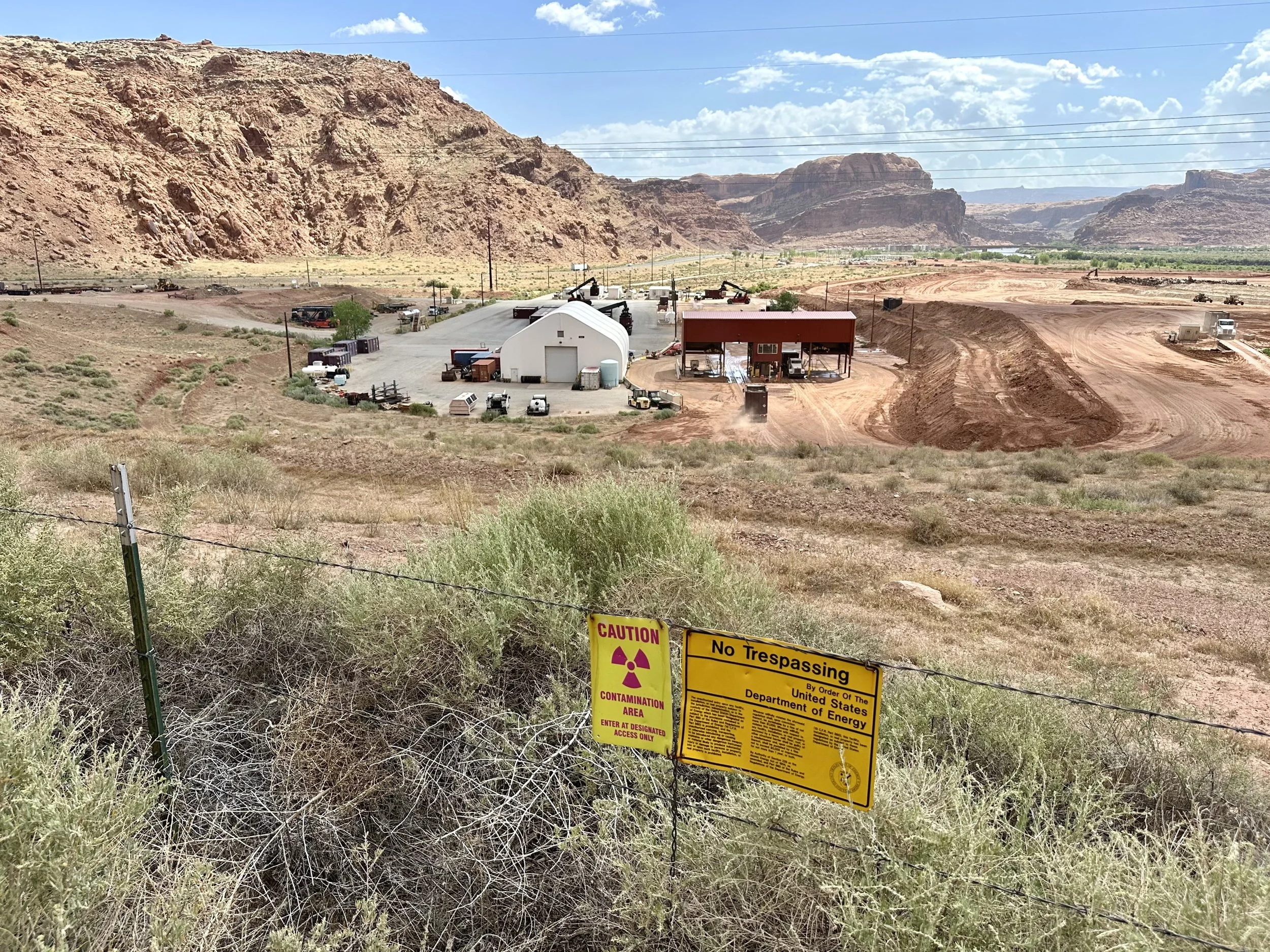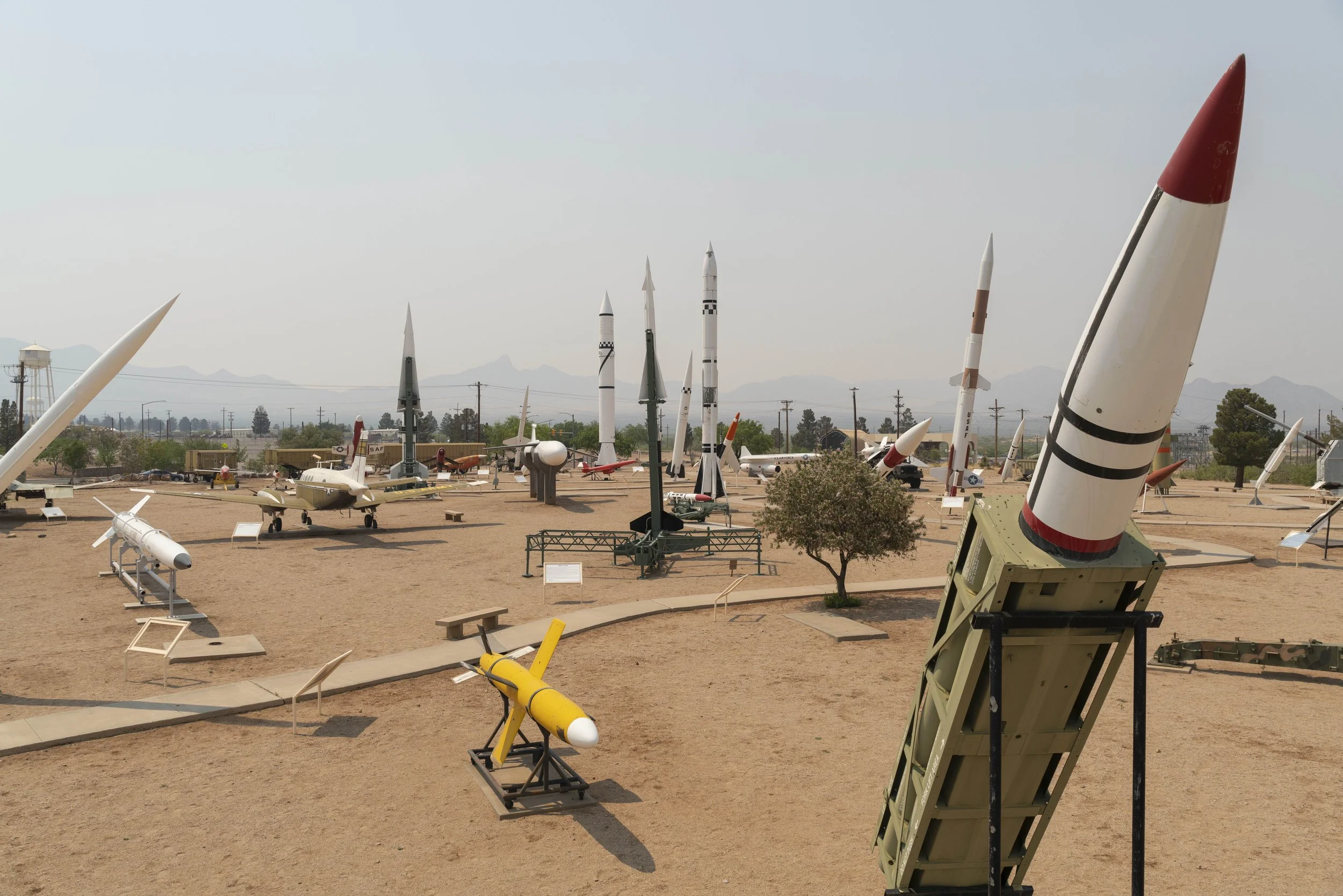Everything and Nothing with “Time Zero”
Writer, instigator, and social (mal)practice artist Sean J Patrick Carney arrives in Houston this week to perform, lecture, and investigate with his ongoing traveling project Time Zero, hosted this Saturday, March 1, at 6:30 p.m. at Basket Books & Art (115 Hyde Park Boulevard).
Carney is a jack of all trades if there ever was one, with decades of well-presented and documented work under his belt and an impressive resume spanning institutions, museums, independent event spaces, and back alleys. I met the experimental artist in Portland, Oregon in the mid-2000s around the time of his stint with the Pacific Northwest College of Arts. From curatorial pop-up projects to his wild and extravagant performances, Carney knew what he was doing when he came to the Pacific Northwest and created a fresh new dialog.
Uranium Mill Tailings Repository, Mexican Hat, UT; a uranium waste disposal site outside of Monument Valley.
Photo: Sean J Patrick Carney, June 2024.
Carney was and still is an un-namable. An artist without a permanent label. He isn’t a performer any more than he is a writer, or a curator, or a new media artist. He works within the energy of the project he is manifesting. His practice is firm, intelligent, and well-rounded with self-criticism, solid throughout the foundations upon which he crafts. In the beginning, I never knew where I stood with him on a professional level, or even a personal level. He was always analyzing, picking, and deconstructing everyone that he worked with or met. It wasn’t that this was a bad practice. It may have been outside of a social norm, but that’s where he thrived as a creative and it made his work stronger. Carney was working alongside the all-the-rage term “social practice” of the early- and mid-aughts. A creative vibe and artistic category that manifested in the Bay Area and hit the scene with momentum. As it would be, Carney started his own Social Malpractice Publication soon after, producing brilliant and clever zines, books, magazines and beyond. His critical writing, essays, and creative interventions appeared in major publications such as VICE, Artforum, and Art in America, and in 2019, he received the Andy Warhol Foundation Arts Writers Grant for Short-Form Writing.
I recently had a moment to catch up with Carney and view some samples of his recent touring project, Time Zero. With each presentation, it appears there is a uniqueness and adaptation that makes the performance and lecture a standalone in an ongoing examination. “Time Zero is a sonic talk on nuclearism, its aesthetics, and its influence on the paranoiac cultural architecture of postwar America,” Carney said in his artist statement. “This live presentation is an adapted preview of the Time Zero Podcast, an episodic narrative on the legacies of nuclear weapons development and testing, uranium mining, atomic energy, and the ethical and engineering paradoxes of nuclear waste disposal.” Launching in late March, the Time Zero Podcast includes interviews with artists Trevor Paglen, Rose B. Simpson, Richard Misrach, Joanna Keane Lopez, and others, as well as Carney’s original drone soundtrack. His performance at Basket Books & Art is adapted to include still and moving images as part of the experience. If it's anything like the piece he recently presented in Los Angeles, then we’re in for an exploratory dive into the dark and often-dystopian realm of the parasitic world of nuclear imperialism.
Moab Uranium Mill Tailings Remedial Action site, Moab, UT; site of an open-air, large-scale uranium mill tailings pile that is currently being moved to a permanent underground storage site to the north.
Photo: Sean J Patrick Carney, June 2024.
Time Zero is a gripping analysis of information, pop culture, literary excavation, and historical injustices. As I watched and listened, I found myself lost deep in the dictation and fully walking on the path Carney was paving. Not solely because I was researching or planning to write, but for the reason of my own new desire for investigation. As a result of his work, I was prompted to look up these sources and discover more within his own materials.
Carney quotes and surveys dozens of books and movies along his inquisition of the nuclear timeline. He provides a vast amount of information and references in a way that brings the viewer and audience into his own wild obsession and leaves you on your own quest to find more of the puzzle pieces. He brings to light the exploitation of the Navajo Nations and the surrounding indigenous peoples of the Southwest, and how the United States stripped their landscapes to mine for uranium or create new testing sites for the hundreds of nuclear bombs being manufactured. As Carney’s story progresses, he uncovers the animation of hidden military bases and militarized installations, many of which operated within miles of settlements or neighborhoods, including one research facility located right inside Los Angeles. The presentation spins a web connecting figures such as David Lynch, Jack Parsons, L. Rob Hubbard, John Wayne, and J. Robert Oppenheimer into a vast dark narrative of the underbelly of the nuclear power grab. Carney continues to uncover the role Hollywood played in nuclearism with the romanticization of the west and the history of the “great” United States. Meanwhile, bombs were being tested only a few mountain ranges away, nuclear materials were being mined from their rocks, and barrelled-up byproducts were stored deep underground, sweeping radioactive dust throughout the southwest and even across the country.
White Sands Missile Range Museum "Missile Park," White Sands, New Mexico; US military base and bombing range that encompasses the Trinity Site, with smoke from the Black Fire wildfire visible in the atmosphere.
Photo: Alex Boeschenstein, 2022.
Time Zero embraces its near-science fiction tone, yet turned on its head with the eerie and disturbing realization that this is all fact. The gross misuse of power to outsmart and outgun “The Reds,” the bright, futuristic advertising that was used to mislead and garner support from the general public under the guise of safety and future gain, and the ticking time bomb of an environmental disaster from the over 500 uranium mines become painfully relevant. Wasteland becomes a verb. Nuclear colonialism takes over the dialog of the native Southwest. The conversation brings as much intrigue as it does sinister moments of truth, many times coming off humorously with its seemingly unrealistic undertones or wild ironies. All keeping in mind that the mining and the thousands of experiments and detonations were happening right outside of our own American cities, later covered up with a few layers of dirt to then become the “Great American Western Frontier.”
While a Saturday night presentation on the world of nuclear gain could seem flat, that would be a mistaken assessment. Carney’s Time Zero is an exceptional and meditative journey that should be experienced in person. His years of critical writing and experimentation come together masterfully within his new project, presented to Houston viewers this Saturday at Basket Books and Art, and includes a prelude by Hannah Spector. Make your plans now, this is going to be one rewarding nuclear timeline.



